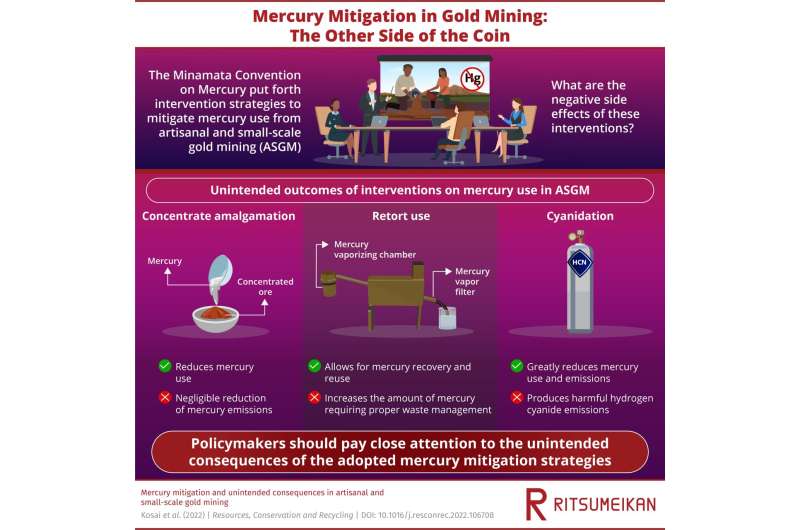Unintended consequences: Analyzing interventions on mercury use and emissions in artisanal gold mining

Mercury is a unique element that has found a myriad of scientific and practical applications throughout the centuries. Besides its well-known role in commercial thermometers, mercury is widely used in artisanal and small-scale gold mining (ASGM) because it forms a liquid amalgam with gold. By heating the mixture, mercury evaporates, leaving behind gold. The problem with this style of ASGM is that mercury vapors, and mercury in general, are extremely dangerous to human health and the environment.
Today, there exists a UN treaty aimed at mitigating the risks posed by mercury through a series of mid- and long-term strategies. In particular, Article 7 of the treaty deals with the problem of mercury in ASGM, stating that party members have an obligation to minimize or outright eliminate mercury use and emissions in such activities within their borders.
Although concrete intervention strategies have been suggested and implemented with some success in this regard, researchers have paid little attention to the side effects that these measures can have.
To tackle this issue, a group of Japanese researchers, including Professors Shoki Kosai and Eiji Yamasue from Ritsumeikan University, examined the effects of the three primary strategies proposed by the UN's Environment Program from a wider perspective. The results of their study were will be published in Resources, Conservation and Recycling.
The three strategies the researchers focused on were the practice of concentrate amalgamation, using a mercury retort, and using cyanide instead of mercury to extract gold. The first strategy involves concentrating the gold ore as much as possible before adding mercury by employing tools such as a centrifuge or a floatation tank. This way, the total amount of mercury needed per gram of gold is greatly reduced. The second strategy is based around the use of low-cost devices called retorts, which are designed to trap harmful mercury vapors and turn them back into liquid mercury. The third strategy involves outright replacing mercury with cyanide-based processes for gold mining.
Using mathematical models and data from 80 countries with ASGM published in the UN's Global Mercury Assessment 2018, the researchers projected the effects of these intervention strategies on global mercury use and emissions up to 2050, as well as their associated unintended consequences. One of the main conclusions of their analysis was that the first intervention strategy—concentrate amalgamation—does not seem to lead to a significant reduction in mercury use nor emissions, though it also does not have significant negative side effects.
In contrast, the use of retorts can considerably reduce the amount of global mercury emissions. However, using retorts also means that there would be a great surge in the amount of liquid mercury that has to be properly managed as a waste product, therefore creating a new problem on its own. Finally, the cyanidation approach does lead to an immense reduction in mercury use and emissions, but replaces them with cyanide emissions, which are also dangerous and toxic to the environment (albeit less than mercury).
In short, when dealing with the problem of mercury in ASGM, it is essential to avoid getting tunnel vision and focus excessively on a few outcome measures while ignoring the totality of the effects of the interventions proposed.
In this regard, Professor Kosai comments that "the findings of our study quantitatively identified the extent of the problems inadvertently created by different intervention strategies. Our results clearly show that the more effective measures for reducing mercury use and emissions require the most attention with regard to their unintended consequences."
The team hopes that, based on the estimates presented in this study, it will be easier to identify and develop the required actions to improve upon each intervention strategy, with the ultimate goal being sustainability in the ASGM field. "There are about 10 to 19 million people involved in ASGM activities in Asia, Africa, and Central and South America. Our efforts will assist in mitigating health damages caused by the absorption of mercury vapors in the future," states Professor Yamasue.
More information: Shoki Kosai et al, Mercury mitigation and unintended consequences in artisanal and small-scale gold mining, Resources, Conservation and Recycling (2022). DOI: 10.1016/j.resconrec.2022.106708
Provided by Ritsumeikan University





















